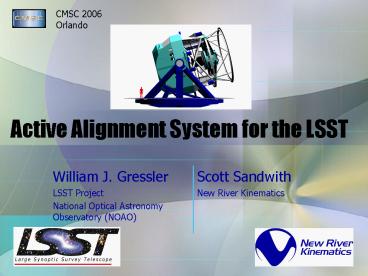Active Alignment System for the LSST - PowerPoint PPT Presentation
Title:
Active Alignment System for the LSST
Description:
Title: Slide 1 Author: scott Last modified by: Your User Name Created Date: 1/17/2006 5:43:27 PM Document presentation format: On-screen Show Company – PowerPoint PPT presentation
Number of Views:84
Avg rating:3.0/5.0
Title: Active Alignment System for the LSST
1
Active Alignment System for the LSST
William J. Gressler LSST Project National Optical Astronomy Observatory (NOAO) Scott Sandwith New River Kinematics
2
Introduction
- Large Synoptic Survey Telescope (LSST)
- Optical Design/Layout
- Operational Requirements
- Active Alignment System
- System Definition
- Alignment Requirements
- Design Methodologies
- Spatial Analyzer (SA) Effort
- SA Model Description
- Technologies Reviewed
- Performance Analysis
3
LSST Optical System
- Modified Paul-Baker Design
- f/1.23
- 3.5 Degree FOV
- 3-Mirror Telescope
- Unique 8.4m M1/M3
- 3.4m M2
- Camera
- 3 Refractive Lenses, 6 Filter Bands
- 63cm Detector
- 3 Billion Pixels/Image!
- 15 Tbytes/night, 5 Pbytes/yr
4
LSST Comparison
Field of view (full moon is 0.5 degrees)
Primary mirror diameter
3.5 degrees
Keck Telescope
5
Optics Subsystem Layout
- 3 Major Optical Subsystems
- M1/M3 Provides Reference Optical Axis
- M1/M3 M2 Active Figure Control
- M2 Camera Hexapods for Rigid Body
- Telescope Survey Operational Cadence
- Open Shutter ? 15sec Exposure
- Close Shutter ? 2sec Readout
- Repeat Sequence for 2nd Exposure
- 5sec Slew to Next Field
- Maintain Alignment During Operation
6
Telescope Control System (TCS)
- TCS Delivers Best Possible Image to Camera
- Multiple Inputs
- Operator
- Enclosure
- Mount
- Sky Camera
- Weather Station
- Wavefront Sensing System
- Active Alignment System
7
Camera Wavefront Sensing
- Wavefront Sensors w/in Camera Focal Plane
- Baseline Curvature Sensors
- Provides Mirror Figure Control Rigid Body
Positioning - No Information While Shutter Closed
Wavefront Sensors (4 locations)
Guider Sensors (8 locations)
Potential Aux. Sensors (16 locations)
3.5 degree Field of View (63 cm diameter)
Sensor Package (9 per Raft)
Raft (21 in FPA)
8
Active Alignment System Description
- Complementary to Focal Plane Wavefront Sensing
- Supports Telescope Alignment
- Initial Site Installation/Mount Model Development
- Re-Assembly after Repair, Recoating, etc.
- Perform Start of Night Operational Setup
- Maintain Alignment of 3 Major Subsystems
- M1/M3 Reference
- M2 Position (5 DOF) Camera Position (5 DOF)
Hexapods
9
Active Alignment System Requirements
- Define Subsystem Fiducials
- Fiducials Define Optical Axis
- Locate on Telescope Mount, M1/M3, M2, Camera
- Incorporate into Final Factory Acceptance Testing
- Measure Fiducials to Maintain Subsystem Alignment
LSST Alignment Requirements
Body Motion Decenter Tilts Piston
M1/M3 Reference Optical Axis Reference Optical Axis Reference Optical Axis
M2 /-10 microns /-5 arcsec /-10 microns
Camera /-5 microns /-2 arcsec /-5 microns
10
System Design Constraints
- Packaging/Line of Sight Issues
- No Interference w/ Light Rays
- See Fiducials for Measurements
- Operational Needs
- Ease of Service / Calibration
- No Heat/Vibration
- Support Full Telescope Pointing (Zenith to
Horizon) - Operational Temperature Range -10C to 25C
- Minimal Warm-up Time Allowed
- High Altitude/Low Pressure
- Sufficient Measurement Speed 30 Second Cadence
- Incorporate into TCS for Closed-Loop Feedback
- Provide Required Accuracies
11
Light Sources
- Measurement Light Sources Must Minimize Camera
Science CCD Impact - lgt1mm Preferred (also 400nm 950nm)
- Pointing system technology (wavelength)
- Ranging system technology (wavelength)
Camera Focal Plane Transmission (Ideal Filters,
Optics, Atmos, QE)
12
System Development Approach
- Study Effort w/ NRK to Define Active Alignment
System using SA Modeling - Baseline Definition Performance Prediction
- Establish Handoff to Wavefront Sensing System
- Uncertainty Analysis for Metrology Controlled
Optical Alignment System - Review Various Technologies
- Laser Tracker
- Laser Radar
- Videogrammetry
13
Measurement Network Simulation
14
Uncertainty Field Analysis
- Metrology Network Optimized (Range Weighted
Optimization) ? Composite Points - Uncertainty Fields Established for Each Composite
Measured Target - Uncertainty Estimate for Telescope Mirror/Camera
Computed with Sets of Target Uncertainty Clouds
in Over-Determined Circle, Planar, and
Cylindrical Shape (Monte-Carlo) - Centering
- Normal Direction Pointing
- Focus Position
15
Metrology System Uncertainty Analysis
16
Tilt Uncertainty Analysis vs. Num of Pts
17
Uncertainty Analysis Conclusions
- LSST SA Model Results
- 3 Metrology Systems Analyzed (Laser Tracker,
Laser Radar, Videogrammetry) - Each System Capable of Meeting Requirements for
Relative Subsystem Position/Orientation - No Perfect Solution (Source l Issues, Total
Measurement Time, etc.)
18
Planned Future Activity
- Continued System Development
- Define Fiducial Geometries for Major Telescope
Subsystems - Engage Metrology Device Vendors
- Review Requirements
- Explain Current Deficiencies Needs
- Perform Measurements at Nearby AZ Telescope Sites
(Similar Operating Conditions) w/ Existing
Commercial Hardware
19
What the sky will look like with LSST
- Survey image shown is 0.5 degree field from Deep
Lens Survey Project - Shows roughly ten times as many galaxies per unit
area (vs. Sloan Digital Sky Survey) - The LSST images will cover 50,000 times this area
in 6 different optical bands (20,000 sq.
degrees!) - LSST will show changes in the sky by repeatedly
covering this area - multiple times per month - 250,000 Type 1a supernovae detected each year
QUESTIONS/COMMENTS

